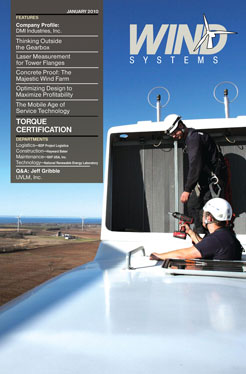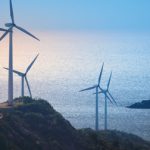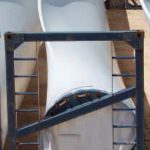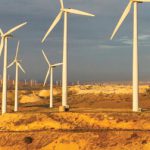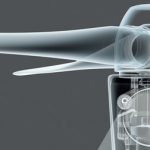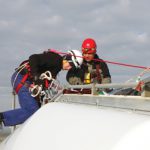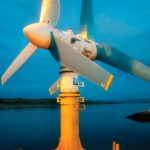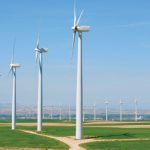The wind industry is currently moving at an incredible pace, despite restrictions mainly having to do with legislative issues. As with anything else, however, that rate of growth will ultimately be governed by technology. Those present at WINDPOWER 2009 in Chicago, hosted by the American Wind Energy Association, saw an incredible show featuring juggernauts such as GE all the way to individuals with new inventions or innovative ideas. Those with problems, and others with solutions, were in the same building, and therefore able to discuss their shared concerns. Among those attending for the first time was Windera Power Systems, Inc., which has developed innovative technologies of interest to the wind industry.
If you travel to Palm Springs, California, and take a drive through the Coachella Valley, you will notice thousands of wind turbines. Something else you may notice is that many of them are not operational. This is because the turbines are broken down, and the brakes are on in order to keep the blades from spinning out of control. If you were to ask the wind farm owners what the problem is, the answer would most likely involve gearboxes. That’s the reason they have extracted problematic gearboxes and set them on the ground in what resembles an automotive graveyard (see Fig. 1).
In fact, this is a problem with wind turbines worldwide. When we ponder wind turbines, we think of cutting-edge technology or future energy. Amazingly, what’s holding this technology back is a component based on technology that’s hundreds of years old: the mechanical gearbox. In other words, the technology of today that is responsible for powering tomorrow is being thwarted by a mechanism that was used by Leonardo Da Vinci. While current gearbox technology is much more sophisticated than those used in Da Vinci’s first machines in the 1400s, of course, it relies on the same fundamental principles of mechanics. Even more astounding is the fact that the problems that he encountered are the same ones we’re dealing with in the wind turbines being built today. There is simply no getting around the fact that a mechanical gearbox creates friction and, as a consequence, heat. In short, it wears down until it eventually fails. The more moving parts to a machine, the more problems one will encounter. These principles, while straightforward, are still the primary culprit that impedes the advancement of wind turbine technology.
Let’s get back to all those turbines standing erect and motionless, not generating any power, and simply wasting away. While wind farm owners can opt to repair the gearboxes and get those turbines up and running for another five or so years, it doesn’t make financial sense. They will have to continue this process, and they will lose money in the long run. That’s where Windera comes in.
Richard Burt, the company’s CEO, developed the technology to solve these problems while working in the solar industry. He saw these turbines in question and discovered the California re-power market. With so many turbines being repaired or overhauled, and countless others wasting away, there is immense potential in implementing this technology to get the wind farm owners back to producing power, and even more efficiently than before. After much work, Burt developed a drivetrain that makes sense for many reasons, one being that there is no gearbox. With this drivetrain design he developed Windera Power Systems, and he continues working to change the wind-energy landscape.
The Windera technology is based on a dynamically controlled, air-cooled, direct-drive, variable-speed hydraulic drive train. This enables the system to deliver ultra-stable AC frequency, voltage, and conditioned power at high efficiencies over a wide range of wind and grid conditions without the use of complex and expensive power inverters. The turbine’s rotor is connected directly to the hydraulic pump in a “direct drive” configuration, which eliminates the need for a gearbox (see Fig. 2).
The design also features a remote monitoring system. Throughout the entire assembly there are various controls and detection devices that monitor temperatures, pressures, and speeds. This information is processed by a CPU and can be remotely sent to headquarters. Windera can monitor this information and contact the owner with any issues that may come up. This means that developing problems are detected immediately, with preventative maintenance information sent to the owner long before costly damage can occur. Another important feature of this particular system is that the unit can be installed down-tower in an enclosure (see Fig. 3).
In other words, Windera can actually link the blades and rotor shaft to the hydraulic pump and, using hydraulic lines running through the tower, link the system with the generator and controls systems on the ground. It’s easy to imagine the cost and time savings this system generates with no more elevators, cranes, or technicians scaling towers to service a single turbine.
The number of kilowatt-hours a wind turbine generates is primarily determined by the average daily wind speed of where the wind turbine is located. An interesting fact about wind energy is that, for up to a third of the year, turbines produce very little usable electricity because the wind speed is near or below their start-up, or “cut-in” speeds, and considerably lower than the rated speed at which they operate most efficiently. As an example, many of the older classes of wind turbines don’t start producing usable electricity until wind speeds reach 10 mph. In many areas wind speeds remain below this level for as much as a third of the year, which means these turbines will only produce usable electricity for two thirds of that time period. In contrast, the Windera system will begin producing usable electricity as soon as the wind is capable of rotating the wind turbine blades, which is approximately three mph. Windera’s advanced design enables power generation at a greater range of wind speeds as compared to conventional wind turbine generators, and as a result can increase power production and wind farm revenues by up to 25 percent or more.
From the first day a turbine is operational there is stress on the assembly from wind. The stress put on the gearbox, driveshaft, and bearings has an obvious negative impact on the lifespan of the turbine. This stress is magnified when the turbine is not operating under “optimum conditions.”
Gearboxes are constantly under duress due to their mechanical nature and the fact that they are not variable-speed. As wind speeds change, stress is put on the gearboxes in the form of friction. As any mechanic knows, friction is the primary nemesis of mechanical machines, from car engines to wind turbines. The stress can also overload the generator and destroy the turbine over time. This is why most turbines last for about five years and usually have a one- or two-year warranty. However, with the Windera drivetrain, all of the excess forces generated by the turbine are converted into heat, although not through mechanical friction. The heat, which is in the hydraulic oil, is cooled with heat exchangers. This heat can be dissipated through the rear of the turbine via fans, or if someone has a use for the heat, it can be harnessed and re-used. Such is the case when the heat is utilized in refractive chillers to heat a building, or in any number of other applications. The fact that the excess heat can be dissipated allows for the amount of power going to the generators to be precisely controlled. This is conducive to the length of the life of the generator and to precise power output control, which not only enables the smooth startup of power delivery to the external electric system, but also allows the control system to prevent spurious power delivery in the case of shutdown due to blade failure, for example. Finally, the system allows for field upgrade opportunities. A machine may be built with the capability of producing more power, but limited to meet certain regulations (e.g. limits on net metering). If those regulations change to allow more power, the software can enable more output power. The drivetrain can be retrofitted into existing turbines such as those found in California, or it can be utilized in new ones. A wind farm owner can now have a turbine that’s more efficient, has lower maintenance costs, and provides a lifespan of 15 to 20 years.
While there are a number of direct-drive designs in the industry, Windera strives to offer the most efficient and logical choice. The company is in the business of eliminating technological barriers that impede progress in the wind energy industry, and to push the boundaries of efficiency and innovation in creating clean energy. Since less than one percent of the electricity consumed in the United States is currently produced by wind, there is a tremendous opportunity for growth, which will require constant innovation. For every challenge that arises in the field of renewable energy, Windera will continue seeking solutions that make both financial and technological sense.



















